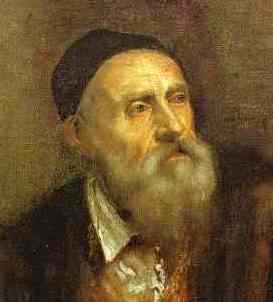The directory «Artists»
Titian
(c.1490–1576)

Venetian painter, whose name was Tiziano Vecellio, b. Pieve di Cadore in the Dolomites. Of the very first rank among the artists of the Renaissance, Titian had an immense influence on succeeding generations of painters, especially in his use of color.
Titian studied painting in the shop of Gentile and Giovanni Bellini. He also worked with Giorgione in 1508 on frescoes (now nearly obliterated) for the facade of the Fondaco dei Tedeschi in Venice. In 1511 he executed frescoes of the miracles of St. Anthony for the Scuola del Santo, Padua. After the deaths of Giorgione and of Giovanni Bellini, Titian was established as the finest painter in Venice. In 1518 he completed the celebrated altarpiece of the Assumption of the Virgin (Church of Santa Maria Gloriosa dei Frari, Venice). During the rest of his career rulers throughout Europe showered him with commissions and honors. His work was eagerly sought by the ducal families of Ferrara, Mantua, and Urbino. Emperor Charles V made him a Count Palatine. Philip II of Spain was also an enthusiastic patron.
In 1545 Titian went to Rome, where he was quartered in the Belvedere of the Vatican. He painted the striking, though unfinished, portrait of Pope Paul III with his grandsons Ottavio (the second Duke of Parma) and Cardinal Alessandro Farnese (Pinacoteca, Naples). For Cardinal Farnese he painted a Danaë (Naples), of which he was later to make several versions. In Rome Titian came into contact with Michelangelo and shared his interest in ancient monuments. Returning to Venice, he was invited in 1548 to Augsburg by Charles V. There he executed many portraits of dignitaries and probably, during the course of his conversations with the emperor, conceived the idea of the magnificent La Gloria (1554; Prado), in which Charles and his deceased wife are presented to the Holy Trinity.
In 1553 Titian began work on a cycle of mythological pictures for Philip II which included Diana and Callisto and Diana Surprised by Acteon (both 1559; National Gall., Edinburgh); the Rape of Europa (1559; Gardner Mus., Boston); and Perseus and Andromeda (c.1555; Wallace Coll., London). Also for Philip II he executed a large number of religious works intended for the Monastery of San Lorenzo del Escorial. Among these were Adam and Eve (c.1570; Prado) and the Martyrdom of St. Lawrence (1564–67; Escorial). After 1552, Titian remained in Venice, living in princely splendor and surrounded by friends who included the writer Pietro Aretino and the architect Jacopo Sansovino.
Titian’s work may be divided into three phases. The first is marked by the strong influence of Giovanni Bellini and Giorgione, exemplified in the so-called Sacred and Profane Love (c.1513; Borghese Gall., Rome) and in the Madonna of the Cherries (c.1515; Vienna). The attribution of certain works such as the Fête Champêtre (Louvre) is still a matter of controversy; some historians attribute the work to Giorgione.
During his second phase (c.1518–1550) there is a full development of the dramatic monumentality characteristic of High Renaissance painting. Typical of this phase are the Pesaro Altarpiece (1519–26; Church of Santa Maria Gloriosa dei Frari, Venice), the Presentation of the Virgin (1534–38; Academy, Venice), and the Christ Crowned with Thorns (c.1542; Louvre). Titian also achieved a greater sumptuousness of color and an evocation of sensuous joy in such pictures as the Worship of Venus (1519; Prado), Bacchus and Ariadne (1523; National Gall., London), and the Venus of Urbino (1537; Uffizi). Many of Titian’s most famous portraits were painted during this period, including La Bella (1537), Ippolito Rinaldo (c.1545; both: Pitti Palace), and the equestrian portrait of Charles V at the Battle of Mühlberg (1548; Prado).
In Titian’s last phase there is an intensification of emotional expression. A deeply personal and mystical spirit becomes visible in a new looseness of brushstroke and subtlety of color. A climactic example is his last painting, the Pietà (Academy, Venice), intended for the artist’s own tomb and finished by Palma Giovane.
Throughout his long and prolific career, Titian explored many pictorial problems. The artist was particularly famous for his innovations in the handling of color, a major preoccupation of the Venetian School. His composition and brushwork, as well, were tremendously influential on later artists. Painters from Velázquez to Balthus have studied and valued his work; he serves as an excellent role model for many painters. His influence is felt more strongly in the 20th cent. than that of any other Renaissance artist.
Liberia, 2000, Battle of Lepanto
Spain, 1938, Allegory of the Battle of Lepanto
Spain, 1938, Allegory of the Battle of Lepanto